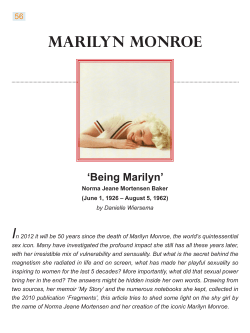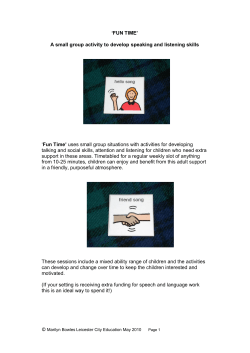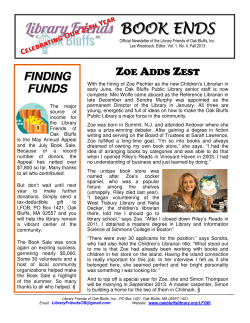
–The Digital Pop Art Creation and Practice Marilyn Monroe
Received April 29, 2013; Accepted June 13, 2013
Marilyn Monroe –The Digital Pop Art Creation and Practice
Chang, Yuh-Shihng
Associate Professor, Department of Digital Multimedia Arts, Shih Hsin University
yhchang@cc.shu.edu.tw
Abstract
Using on the arduino microcomputer chip, the iconic image of Marilyn Monroe in the film, “The Seven Year Itch” is used
with movements made by wind as interactive media. The artwork uses a large fan to bring Monroe to life. The creation
takes one of Andy Warhol's classic Pop Art works – “Marilyn Monroe” as the original concept which is combined with
interactive media to let audiences interact with the Pop Art style of Marilyn Monroe with the essence of Pop Art in spirit.
Modern Pop Art demonstrates a series of visual images. In digital technology and the art aesthetics trend, this creation
combined digital pop art with interactive devices allows users to participate and become the part of the art work, then
create an experience for the visual pleasure of a continuous, dynamic image.
Keywords:
Marilyn Monroe, Pop Art, Interactive
In creation of digital art, there are many cases of taking the
concept of wind as interactive medium. When the fan starts,
the wind will flow. Thus, the users in the performances space
not only could have the visible phenomenon for wind, which
was originally invisible to the eyes ,but also the physical
senses in which could feel the flow of air. For instance, the
work, “Blow Up”, by American artist, Scott Sona Snibbe,
constructed a wall of 12 small fans, and then using it in the
same way in the opposite position, formed a wall of 12 large
fans, then, the users could control the large fans by blowing
the small fans one by one, so, the fan walls were driven by the
interface with each other, creating a form of an endless air
flow effect [3].
1 Background
In recent years, interactive device have been combined with
technology, by which it has become the so-called new media
art. In many places, such as museums, art galleries or
exhibitions from different regions, new media art has become
the performances milestone since it combined with interactive
elements. Digital technology has driven a change on
production methods for audio and video editing, clips and
synthesis. Meanwhile, the realistic or mix method provides the
creator a tremendous challenge to the traditional concept of
the creative fields [1].
From computer art to media art, and then developing to the
digital art or new media art, its application value had
progressed into the field of science, and even life design
application for pure art exhibition and appreciation. Interactive
devices are a part of new media art, since it has the
characteristics interaction, the participation of the audience
becomes a part of the work beyond the function of just looking.
The work value lies in the situational experiences through the
interaction.
In “Flow 5.0”, Daan Roosegaarde constructed two walls and
walkway made of hundreds of small digital fans, and then
letting the users walk in to this fan walkway to lead them to
feel it is a virtual environment by its interactive technology. It
is clear that the wind is an obvious media related to sense our
existing space in our daily lives. The creation takes human
breathing to explore human presence and perception. On his
website, Scott Snibbe argues for this creation that: in the
physical world, our bodies get perceived through some of
phenomenon; we hear our voices through the vibration of air
sound; we see our faces through bending light, breathing also
as one attribute of the human fundamental nature. By
breathing, we present that we are autonomous individuals [4].
One notable example of these interactive experiences was
used at the Digital & Interactive Gaming Conference, held in
London in January 2008 [2], it took a game as the theme to
explore interactive experience to go further in exploring how
gaming and interaction be become very integrated in digital
media. For instance, an application for teaching media design
with game concepts can improve the entertainment of the
application and make a change on human communication in
the way modern society uses by digital media. The conference
participants included digital art creators, experts, scholars,
digital technology researchers and students. The Seminar sites
also presented many of the latest technologies and its
experiential creation works. By taking a game as an idea to
catch human curiosity, and the attractive feature of art, it had
indeed captured the eyes of audiences.
Based on the above viewpoint, this creation work takes the
movement of wind as interactive media to connect with Pop
Art. An animated performance with the iconic image of
Marilyn Monroe in the film, “The Seven Year Itch”, takes an
arduino microcomputer chip as a basic controller to create the
feeling of wind. The switch of the fan is given to the users for
the interactive experience. The related artistic motivation,
design process, and its experimental tests are presented in
following sections.
44
is the interactive interesting; Megatrends's author, John
Naisbitt, said that "First of all you have to do something
interesting, if you want to sell products, inspire employees,
and attract customers". In the post-modern society,
entertainment is seen as an essential element in our life.
Based on the above statement, this creation takes one of Andy
Warhol's classic works, Marilyn Monroe, as the model to
connect interactive art to let the audience interact with
Marilyn Monroe in the spirit of Pop Art. In contemporary art,
its pop performs a series of visual image. In digital technology
and the art aesthetics trend, this creation aims to combine
multimedia and digital pop art with interactive devices so as to
allow the users to participate in part of the digital media,
allowing them to experience the visual pleasure of a
continuous, dynamic image. By using the flow of wind as part
of medium, this creation attempts to create an animated
performance of Marilyn Monroe through the interaction with
users.
2 Artistic Motivation
During the early 20th century, Marilyn Monroe is a famous
movie star in the United States, whose attractive performance
style led her to become a sexy symbol. Because of this, she
later became one of the most memorable figures in popular
culture [5]. After, Marilyn Monroe committed suicide, the
American Pop artist, Andy Warhol, quite shocked by her death,
was inspired to create the artwork “Marilyn Monroe”. This
work became one of the famous masterpieces of Pop Art, seen
in figure 1 [6]. In “The Seven Year Itch”, Marilyn wearing the
flowing white dress thus became a memory impressed deep
into our minds, it also became an inspiration for many artists
as an object for imitating or acting (as figure 2).
3 The design process and practice
3.1 The original concepts
Interaction Design (its abbreviations as “IxD” or “IaD”) is a
new subject field which integrates human science, technology,
culture, and aesthetics. According to the definition from
Wikipedia [8], interactive design is a field of artificial systems
and behavior. Interactive design can create the experience of
communication and its interaction with the users. And is thus,
interactive design is an essential element for the processes of
production, for example, software, mobile devices, artificial
environment, services, portable devices, and the structure of
system organization.
Through the system of interactive design, we could create a
positive reaction, as well as the experience of ease, comfort
and its emotional feedback. Among them, how to create an
emotional reaction to the users is to allow them to have its
positive memory as the mainstream design of concept [9]. In
the creation of interactive devices, the designers usually take
the direct, natural, and instant design considerations. However,
most natural interactive methods should be based on the
intuition to operate, by using the input image and its
interactive interface to communicate with computer. This
leads the computer to perform its action so as to get the visual
and audio feedback to achieve the effect of interaction [10].
The creation uses arduino microcomputer clip as the main
controller, by mean of the switch of the fan, its positive and
negative magnetic conversion gives a signal to the computer to
control the speed of the wind to play different sections of
Marilyn Monroe's flowing white dress. Its visual art elements
represent Pop Art. The image of Marilyn Monroe is collected
from Andy Warhol's “Marilyn Monroe” and not from human
acting. When the users switch on the control of movements of
the fan, by the Pop Art, and the visual image of Marilyn
Monroe's flowing white dress can be seen, the interactive
viewing experience is created as well. This artwork‟s hardware
device included a the fan integrated with arduino clip,
multimedia PC, LCD screen, and a projector. The creation's
design and its devices are shown in figure 3, the output
Fig. 1 The iconic of Andy Warhol's Pop Art
Resource: [6]
Fig.2 “The Seven Year Itch” Photo of Marilyn Monroe
Resource: IMDb [7]
How to provide interesting interaction to the users is an
emphasis on how the concept of interactive technology and art
is integrated in performance. Interaction is a process of
communication between the work and the viewers, which the
interactive should be focused on the viewer's cognitive and
mental level, the art will be based on one-on-one to
interactions to its message, by which progress of the
interaction changes with the user. Its interactive behavior will
change the result of each performance. The value of digital art
45
projection of visual animation in figure 4.
Fig3. The schema design of Marilyn Monroe (Digital Pop Art)
Fig 4. The screen output of Marilyn Monroe (Digital Pop Art)
46
fan will affect the overall animated presentation. The stronger
fan signal, the larger the movement and angle of Marilyn
Monroe‟s white dress will be flowing in. The output for this
animation is projected onto a wall screen. The end-result is an
interactive piece of Marilyn Monroe, where the audience can
control the movement of the fan creating different animations,
as in figure 5.
3.2 The system architecture
The composition of this creation includes input an electronic
fan as well as an arduino microcomputer chip. It uses this
computer chip to make sure whether if the fan is activated.
Through the speed of fan blades, the different signals are
created. The fan‟s power is divided into 7 levels; 0 to 6. These
different levels are then sent to a computer. The artwork is
created with Adobe Flash, and the massages received from the
Fig. 5 The system architecture of Marilyn Monroe (Digital Pop Art)
“Pop Art” is derived from an English Independent Group, and
originally defined as a discarded, temporal, free consuming
culture. That made it a reaction for political satire, including
comic style, cartoon characters, popular idols, and mixing
colored small objects in daily life, this presented the popular
culture during the 1950‟s. In the 1960s, Andy Warhol, held an
exhibition which he presented by Campbell Soup cans, Coke
bottles, money, and celebrities' portraits as artwork. Its Pop
creative elements charmed its way into mainstream media,
causing a sensation.
How do we identify the feature of Pop Art? On July 1st, 1957,
Hamilton wrote the definition of pop art: “Pop art is popular,
can be expanded (easy to forgot), mass-produced ( as cheap),
young, smart, spelling, and commercialization”. From the
above definition, we may easily think of it as what was
popular with young adults at the time; such as idols, love, or
sex, brilliant colors (such as magenta, bright yellow, bright
orange, apple, and green), as well as generous geometric
patterns or lines (for example, heart-shaped, round, square,
colored lines, and spots ) into patterns[11].
In order to further add to the style of Pop Art, the work uses
magenta heart shapes and other colorful animations onto
background of Monroe for the performance. Thus, this
Marilyn Monroe creation has a Pop Art as well as pleasing,
visual effect. (as figure 6, 7)
Fig. 6 The Pop Art style of the pattern in the work
47
In the program about how to drive the Monroe‟s show and
specified pop art effect according the strength of wind, which
is coding as below tow parts. The first part of program is the
function which is received the message from fan and detecting
the strength of wind from Arduino clip.
var randomValue = 0;
Mouse.hide();
aListener = new Object();
aListener.onConnect = function()
{trace("** Arduino connected! **");};
aListener.onConnectError = function()
{trace("** Arduino connection Failed!
check the port number and serialProxy **");};
//this gets triggered when Flash disconnects from Arduino
aListener.onDisconnect = function()
{
trace("** Arduino disconnected! **");
};
//this gets triggered when Flash receives data from Arduino
aListener.onReceiveData = function(evtObj:Object)
{
//trace(evtObj.data);
var inData = evtObj.data;
Fig. 6 The Pop Art style of the pattern in the work
3.3 The programs coding
Just like the about Roosegaarde‟s approach is that his famous
work - FLOW 5.0 [4] are not simply built and let everyone
feel inside his work with wind. So, this work must install
adapting the software and wind materials to create new
contexts, and strategies of interaction for the audience.
When the audience switch on the fan in the space of exhibition,
the arduino clip can detect the rotation speed of the fan and
transfer a message code to computer, which the clip is
installed in the fan. In the meanwhile, the flash program had
received the message, and then derived the Monroe‟s show
according the value of message code, which was divided into
four levels. More strength the wind, the action level would be
dramatic more, and greater of Monroe's skirt fluttering
magnitude. In order to create the visual effect, the pop art
patterns also match Monroe‟s show, more the strength of wind;
the effects will be more gorgeous. The audience on the switch
of fan, the show action will play it once. After the Monroe's
show was end, the work will return to the ready situation to
wait for the next audience interaction. The flowchart for the
audience interacting with Monroe is listed below (Fig. 7):
if (inData == 0){
randomValue = 0;
//trace("none");
trace(randomValue);}
if (inData == 1){
randomValue = 11;
//trace("weak");
trace(randomValue);}
if (inData == 2){
randomValue = 12;
//trace("middle");
trace(randomValue);
}
if (inData == 3){
randomValue = 13;
//trace("strength");
trace(randomValue);}
};
var a:Arduino = new Arduino(5332);
a.addEventListener("onConnect",aListener);
a.addEventListener("onConnectError",aListener);
a.addEventListener("onDisconnect",aListener);
a.addEventListener("onReceiveData",aListener);
The second part of program is to drive Monroe’s show
according the strength of the wind, which is transformed to the
code of „randomValue‟ in the first part of program.
showAnimation();
function showAnimation() {
if (randomValue == 0) {
Fig. 7 A flowchart for detecting the fan wind of the work
48
tellTarget ("mary")
{gotoAndStop(1);}
}
[6] Xu Lwen (許麗雯), You must know 300 paintings and their
painters and painting genre (你不可不知道的 300 幅名畫及
其畫家與畫派),Chinese edition, Taipei, Gao-Tan Museums
and art galleries(高談文化藝術館),2006.
[7]IMDb, The Seven Year Itch Photos with Marilyn Monroe,
Mptvimages.com,
Retrieved
from
http://
www.imdb.com/media/rm2879166464/tt0048605, 2012.
[8]Wikipedia,
Interactive
Design,
Retrieve
from
http://en.wikipedia.org/wiki/Interaction_design, 2012.
[9]Preece,J., Roger, Y., & Sharp, H.: Interaction Design:
Beyond Human-Computer Interaction, John Wiley & Sons.,
NY, 2003.
[10]Sung Heng, Wang Chao Ming, and Lee Chi Wei, New
Approach to Digital Art –Using Projection of Materiality to
Design the Virtual and Physical Interactive Scenario, 2007
Hawaii International Conference on Arts and Humanities,
Hawaii, pp. 5151-5159, 2007.
[11]Julier,G., 20thcentury design and designers, Second
Edition, The Thames & Hudson Publishers, 1993 .
if (mary._currentFrame == 1 ||
mary._currentFrame == 76 || mary._currentFrame == 165 ||
mary._currentFrame == 245 || mary._currentFrame == 1)
{
if (randomValue == 0){
tellTarget ("mary")
{gotoAndStop(1);}}
if (randomValue == 11){
tellTarget ("mary")
{gotoAndPlay("level1");}}
if (randomValue == 12){
tellTarget ("mary")
{gotoAndPlay("level2");}}
if (randomValue == 13){
tellTarget ("mary")
{gotoAndPlay("level3");}}
}
}
4 Conclusions
The significance of new media to the users, is not only a
efficient and high productivity for work, but emphasizes on
entertainment, enjoyment, and interest. It can inspire an
experience of perception in the aspect of aesthetic and
creativity, in which it is the key point of the modern
interactive design. This creation takes interactive art as a
thought and takes a technical aspect as a new way for thinking.
Using the means of the interaction between the users and the
artwork, the diversity of art thus presented. Pop Art can create
a series of visual images; this creation thus can bring a fun
form of continuous dynamic visual movement. That is,
through the combination of digital technology and art to
embody a form of visual art and digital design. The creation
attempts to combine the interactive art with technology, and
then with the users' interaction in order to represent the spirit
of Pop Art, the art style is easy to understand since it is
common amongst our daily lives.
References
[1]Christiane Paul, Digital Art, Thames & Hudson Ltd,
London, 2003.
[2]Wikipedia, Digital & Interactive Gaming Conference,
Retrieve
from
http://en.wikipedia.org/wiki/
Digital_%26_Interactive_Gaming_Conference, 2012.
[3]Snibbe, S.S: Blow Up, Retrieve from http://
www.snibbe.com/projects/interactive/blowup/, 2012.
[4]Roosegaarde, D.: FLOW 5.0, Retrieve from http://
www.dezeen.com/2007/12/13/flow-50-by-studio-roosegaarde/,
2012.
[5] Churchwell, Sarah., The Many Lives of Marilyn Monroe,
Metropolitan Books. 2005.
49
© Copyright 2025


















